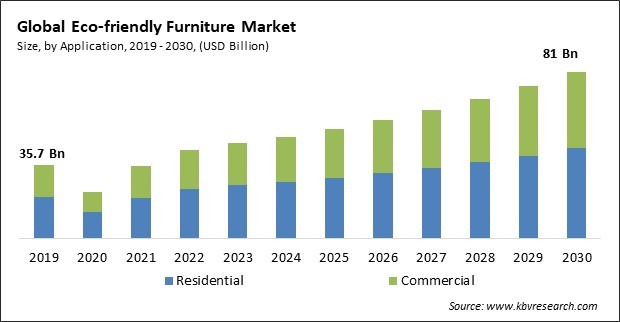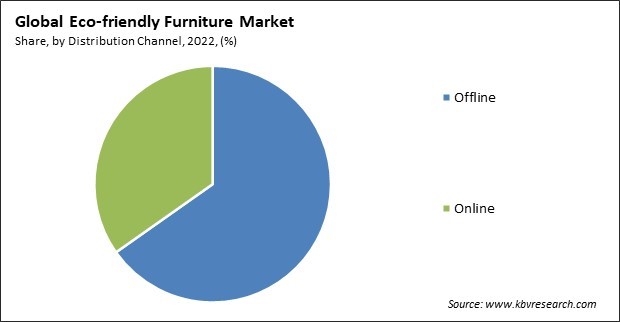
The Global Eco-friendly Furniture Market size is expected to reach $81 billion by 2030, rising at a market growth of 8.3% CAGR during the forecast period.
E-commerce platforms offer a wide range of eco-friendly furniture options, providing convenience and accessibility for consumers who prefer to shop online. E-commerce platforms offer consumers the convenience of shopping for eco-friendly furniture from the comfort of their homes. Thus, the Online segment would capture 2/5th share in the market by 2030. This accessibility is especially attractive to busy individuals who may not have the time to visit physical stores. E-commerce websites typically provide detailed product descriptions, including information about the materials used, certifications, and eco-friendly features. This transparency helps consumers make informed decisions based on the sustainability criteria they prioritize. Many online sellers prominently display eco-friendly certifications and labels for their furniture products. This helps customers identify which items meet specific sustainability standards and eco-friendly criteria. Some of the factors impacting the market are growing green building and LEED certification, expansion of health and wellness trends, and high cost and affordability of eco-friendly furniture.

The growth of green building projects seeking Leadership in Energy and Environmental Design (LEED) certification has created a strong demand for eco-friendly furniture, especially in the commercial and hospitality sectors. Green building projects prioritize sustainable construction practices, which include selecting environmentally responsible furniture. Builders and designers often seek eco-friendly furniture to ensure that all aspects of the project align with sustainability goals. Green building designs often prioritize occupants' health and well-being. It improves indoor air quality, reducing harmful chemicals and allergens. Green building practices and LEED certification play a significant role in promoting the market. Additionally, Health-conscious consumers are concerned about indoor air quality. It is often made from low-VOC (volatile organic compounds) or non-toxic materials that release fewer harmful chemicals into the indoor environment. This contributes to cleaner and healthier air. Eco-friendly furniture, particularly pieces made from hypoallergenic materials, can reduce common allergens like dust mites, pet dander, and mold. It can be designed to align with biophilic principles, incorporating natural textures and materials that contribute to a calming and soothing environment. The concept of holistic living encourages the creation of living spaces that support overall well-being. As a result of the expansion of healthy living, the market is estimated to increase.
However, It can be more expensive than conventional furniture due to sustainable materials and responsible production methods. This cost difference can be a barrier for price-sensitive consumers. It often requires using sustainable and responsibly sourced materials, which can be more expensive than traditional materials. Additionally, sustainable production methods, certifications, and ethical labor practices can increase production costs. Eco-friendly furniture is sometimes perceived as a premium product, leading to the expectation of higher prices. This perception can deter budget-conscious consumers. The high cost and affordability of eco-friendly furniture can pose challenges to the growth and adoption of the market.
Based on distribution channel, the market is bifurcated into offline and online. In 2022, the offline segment witnessed the largest revenue share in the market. Physical stores and showrooms allow customers to experience the quality and craftsmanship of eco-friendly furniture firsthand. They can touch, sit on, and assess the furniture, gaining a tactile understanding of its comfort and durability. Customers can explore a wide range of design options and styles in a physical store. This lets them visualize how eco-friendly furniture fits into their home or commercial space. The ability to see the furniture in a real-life setting is an advantage for making design decisions.

By application, the market is categorized into residential and commercial. The commercial segment covered a considerable revenue share in the market in 2022. The commercial segment often involves large-scale projects that require a significant quantity of furniture. When businesses and organizations choose to use eco-friendly furniture, it results in a substantial increase in demand for sustainable products. In commercial spaces, employee health and well-being are of paramount importance. Eco-friendly furniture, often made from non-toxic, low-VOC (volatile organic compounds) materials, contributes to a healthier indoor environment.
| Report Attribute | Details |
|---|---|
| Market size value in 2022 | USD 43.2 Billion |
| Market size forecast in 2030 | USD 81 Billion |
| Base Year | 2022 |
| Historical Period | 2019 to 2021 |
| Forecast Period | 2023 to 2030 |
| Revenue Growth Rate | CAGR of 8.3% from 2023 to 2030 |
| Number of Pages | 167 |
| Number of Table | 240 |
| Report coverage | Market Trends, Revenue Estimation and Forecast, Segmentation Analysis, Regional and Country Breakdown, Companies Strategic Developments, Company Profiling |
| Segments covered | Distribution Channel, Application, Region |
| Country scope | US, Canada, Mexico, Germany, UK, France, Russia, Spain, Italy, China, Japan, India, South Korea, Singapore, Malaysia, Brazil, Argentina, UAE, Saudi Arabia, South Africa, Nigeria |
| Growth Drivers |
|
| Restraints |
|
Region-wise, the market is analysed across North America, Europe, Asia Pacific, and LAMEA. In 2022, the North America region led the market by generating the highest revenue share. Environmental consciousness has grown significantly in North America, with more consumers and businesses recognizing the importance of minimizing their carbon footprint and safeguarding natural resources. North Americans increasingly consider the impact of furniture on indoor air quality. The North American region boasts many eco-friendly furniture options, including different styles, materials, and price points.
Free Valuable Insights: Global Eco-friendly Furniture Market size to reach USD 81 Billion by 2030
The market research report covers the analysis of key stake holders of the market. Key companies profiled in the report include Inter IKEA Systems B.V., Cisco Brothers Corp., Greenington Fine Bamboo, Williams-Sonoma, Inc., Ashley Furniture Industries, LLC, Lee Industries, Inc., Sabai Design, Inc., La-Z-Boy Incorporated, Ethan Allen Interiors Inc., and Maiden Home, Inc.
By Application
By Distribution Channel
By Geography
This Market size is expected to reach $81 billion by 2030.
Growing green building and LEED certification are driving the Market in coming years, however, High cost and affordability of eco-friendly furniture restraints the growth of the Market.
Inter IKEA Systems B.V., Cisco Brothers Corp., Greenington Fine Bamboo, Williams-Sonoma, Inc., Ashley Furniture Industries, LLC, Lee Industries, Inc., Sabai Design, Inc., La-Z-Boy Incorporated, Ethan Allen Interiors Inc., and Maiden Home, Inc.
The expected CAGR of this Market is 8.3% from 2023 to 2030.
The Residential market dominated the Market by Application in 2022; thereby, achieving a market value of $43.9 billion by 2030.
The North America region dominated the Market by Region in 2022 and would continue to be a dominant market till 2030; thereby, achieving a market value of $34.1 billion by 2030.
Our team of dedicated experts can provide you with attractive expansion opportunities for your business.
